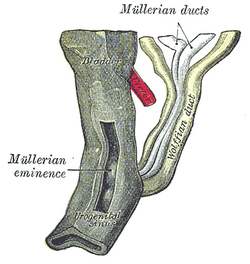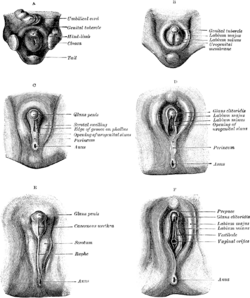Urogenital sinus
| Urogenital sinus | |
|---|---|
 Urogenital sinus of female human embryo of eight and a half to nine weeks old. (Urogenital sinus labeled at bottom.) | |
 Stages in the development of the external sexual organs in the male and female. ("Opening of urogenital sinus" labeled in diagram D.) | |
| Details | |
| Carnegie stage | 15 |
| Precursor | Cloaca |
| Gives rise to | urethra, bladder, vagina |
| Identifiers | |
| Latin | sinus urogenitalis definitivus |
| TE | sinus_by_E5.7.3.1.0.0.1 E5.7.3.1.0.0.1 |
| Anatomical terminology | |
The urogenital sinus is a part of the human body only present in the development of the urinary and reproductive organs. It is the ventral part of the cloaca, formed after the cloaca separates from the anal canal during the fourth to seventh weeks of development.[1]
In males, the UG sinus is divided into three regions: upper, pelvic, and phallic. The upper part gives rise to the urinary bladder and the pelvic part gives rise to the prostatic and membranous parts of the urethra,[1] the prostate and the bulbourethral gland (Cowper's). The phallic portion gives rise to the spongy (bulbar) part of the urethra and the urethral glands (Littré's). The penile part of the urethra originates from urogenital fold.
In females, the pelvic part of the UG sinus gives rise to the sinovaginal bulbs, structures that will eventually form the inferior two thirds of the vagina. This process begins when the lower tip of the paramesonephric ducts, the structures that will eventually form the uterus and vaginal fornices, come in contact with the UG sinus. Shortly afterwards, the sinovaginal bulbs form as two solid evaginations of the UG sinus. Cells in these bulbs divide to form a solid vaginal plate, which extends and then canalizes (hollows) to form the inferior portion of the vagina.[2] The female urogenital sinus also gives rise to the urethra and vestibule of the vagina.
Clinical significance
A urogenital sinus anomaly is also a rare birth defect in women where the urethra and vagina both open into a common channel.[3][4]
A persistent cloaca is a disorder where the rectum, vagina, and urinary tract meet and fuse, creating a cloaca, a single common channel.[5]
Other animals
In most mammals (excluding primates and species that have a cloaca), the urogenital sinus refers to the sinus in which the openings to the female's urethra and vagina are found. The urogenital sinus of non-primates is homologous to the vulval vestibule of primates.
Additional images
-
Enlarged view from the front of the left Wolffian body before the establishment of the distinction of sex.
See also
References
- ^ a b Sadler & Langman 2010, pp. 243–244.
- ^ Sadler & Langman 2010, pp. 253.
- ^ Callahan, Gerald N. (2009). Between XX and XY : intersexuality and the myth of two sexes. Chicago, Ill.: Chicago Review Press. p. 182. ISBN 978-1-56976-289-9. OCLC 436089205.
- ^ "Urogenital Sinus". Children's Hospital of Orange County. 2023-02-23. Retrieved 2023-10-07.
- ^ Jenkins D, Bitner-Glindzicz M, Thomasson L, et al. (2007), "Mutational analyses of UPIIIA, SHH, EFNB2 and HNF1β in persistent cloaca and associated kidney malformations", J Pediatr Urol, 3 (1): 2–9, doi:10.1016/j.jpurol.2006.03.002, PMC 1864944, PMID 17476318.
Sources
- Sadler, T. W.; Langman, Jan (2010). Langman's Medical Embryology. Philadelphia: Lippincott William & Wilkins. ISBN 978-0-7817-9485-5. OCLC 1194422650.
External links
- "Pediatric Conditions - Abnormalities - Vaginal Anomalies: Urogenital Sinus". UrologyHealth.org. 2003-04-29. Archived from the original on 2004-02-18.
- "Fetal Pig Dissection". Medicine LibreTexts. 2020-10-15. Retrieved 2023-10-08.
- "Development of the reproductive system". Amboss.com. 2022-03-30.
- "Differentiation of the urogenital sinus in males". embryology.ch. 2007-09-27. Archived from the original on 2018-02-15.
